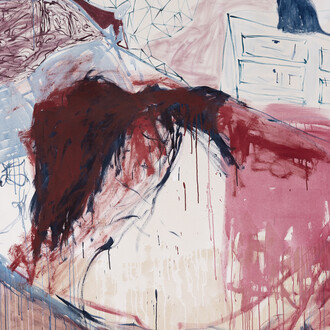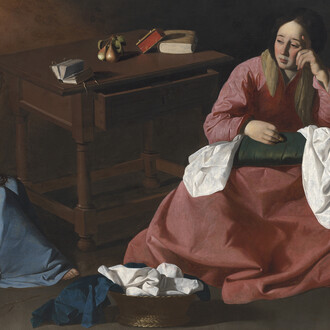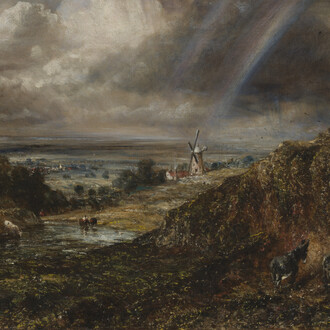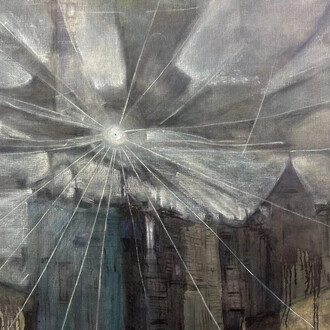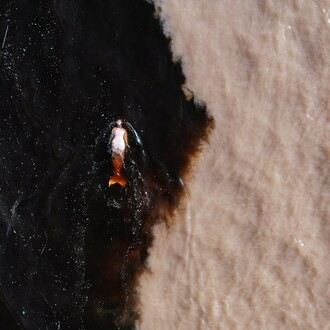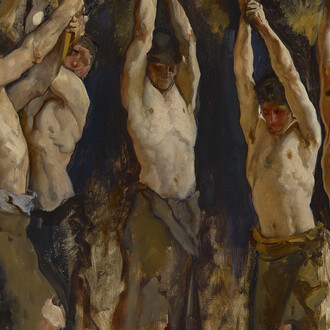I cannot experience your experience.
You cannot experience my experience.
We are both invisible men.
All men are invisible to one another.(The politics of experience [1967], R. D. Laing)
What does it mean to translate experiences, especially those rooted in culture, identity and memory, into a visual language? Lost for words brings together four international artists - Magda Blasinska, Jonathan Callan, Vitaliia Fedorova, and Lavinia Harrington - working with painting, drawing, video and installation. Each artist attempts to give voice to the unspoken, the unshared, the incommunicable. Their works emerge from personal narratives and blend into collective ones, highlighting the ambiguity of how those experiences are perceived by others.
In an increasingly globalised world, cultural translation has become both a necessity and a challenge. While the task to promote mutual understanding across cultures is constantly present, the demand for quick legibility risks obliterating the nuances. What gets lost when we rush to understand one another? How can we communicate across distances while still recognising the differences? Rather than offering clear resolutions, the artists in Lost for words plunge into the messiness of language, gesture, and memory. They explore the fragile space between knowing and not-knowing, between saying and sensing. Their practices reflect a resistance to easy translation and a commitment to the tactile and unstable ways in which experience can be shared.
Predominantly a painter, Magda Blasinska’s (b. 1983, Poland) work is guided by sensory experiences, memory and intuition. Raised in post-communist rural Poland, a period marked by shortages, restrictions and surveillance, her pieces reflect her humble upbringing. Through the use of a limited earthly colour palette and marginal materials, her work draws on agriculture and folk heritage.
Blasinska’s paintings are immersive and elusive, they dwell in the space between knowing and guessing, offering viewers something that feels intimately familiar yet difficult to fully grasp and describe with words. Each brushstroke is a record of repeated gestures, of pressure and resistance. Her work becomes a translation of experience not into words, but into touch - insistent, physical, and enduring. Language and its limitations are one of the recurring themes in Blasinska’s practice. Raised by parents who knew Russian but refused to speak it to her, the artist engages with the Cyrillic alphabet as both an intimate memory and an abstract form. Like in Gathered signs, her invented words, formed from fragmented Cyrillic elements, are intentionally unreadable, offering visual echoes of a language without meaning, hovering between the familiar and the foreign.
Lavinia Harrington’s (b.1986, UK) pastels on paper appear soft and effortless, yet are the result of a labour-intensive process. Working directly with her hands, she embeds pigment into paper by folding, soaking, and rubbing until the material carries its own emotional weight. The resulting pieces, reworked and folded multiple times, hold and transmit sensations of vulnerability and fragility as well as strength. The tactility of paper becomes a metaphor for the body: how much can it hold before it breaks? Each fold is a scar, a memory, carrying something unspoken. Harrington’s cultural and professional background lies in the Italian Renaissance. The colours and texture of 14th and 15th century frescoes inform her palette and material sensitivity. While making No forcing and no holding back, she was reflecting on the famous Giotto frescoes in the Scrovegni Chapel. The memory of Giotto’s angels rolling up the sky recurs in her thinking: ‘How striking to imagine something as limitless as the sky rolled up like paper, with such a dense and vividly pink verso’.
Vitaliia Fedorova (b. 1996, Ukraine) is a London-based multidisciplinary artist whose practice explores the space between introspection and social commentary, transforming personal experiences into collective narratives through storytelling.
Her two-channel video installation Carillon is a quiet portrait of her 72-year-old grandmother - a refugee who fled Ukraine for Wales. Resisting drama, the film gently lingers in the ordinariness of exile: dyeing her hair, making traditional food, drinking tea — gestures of routine carried out in a semantically and physically unfamiliar environment. The dual screens occasionally align to create imagined panoramic views, expanding the borders of the new woman’s limited reality. Subtitles - translating her grandmother’s shifting speech between Ukrainian and Russian - play a central role. Rather than offering literal transcription, they act as selective interpretation, emphasising that something always remains untranslatable. In the film, the grandmother is learning English, which becomes a metaphor not just for integration but also for loss. As Hannah Arendt writes in We refugees, to lose one’s language is to lose the “naturalness of reactions” and the “unaffected expression of feelings.”
Jonathan Callan’s (b. 1961, UK) practice interrogates the very limits of language. Deeply fascinated with the dominance of literature in British culture, his work questions what is overlooked when we rely too heavily on words to convey experience. In his major piece, The genius of british painting and my commentary, Callan meticulously handwrites over an existing art history text, weaving in his personal commentary. The result is a dense, layered surface that resembles a textile more than text, legible, yet not made to be read. It becomes both a visual translation and a conceptual disruption, pointing to the labour of meaning-making itself.
Callan’s annotations are sharp: the greatest British painters were often immigrants; Turner, one of the most celebrated, was barely literate. These facts destabilise national narratives and highlight how identity and cultural worth are themselves constructs, subject to revision and retranslation, and often lost for words.









